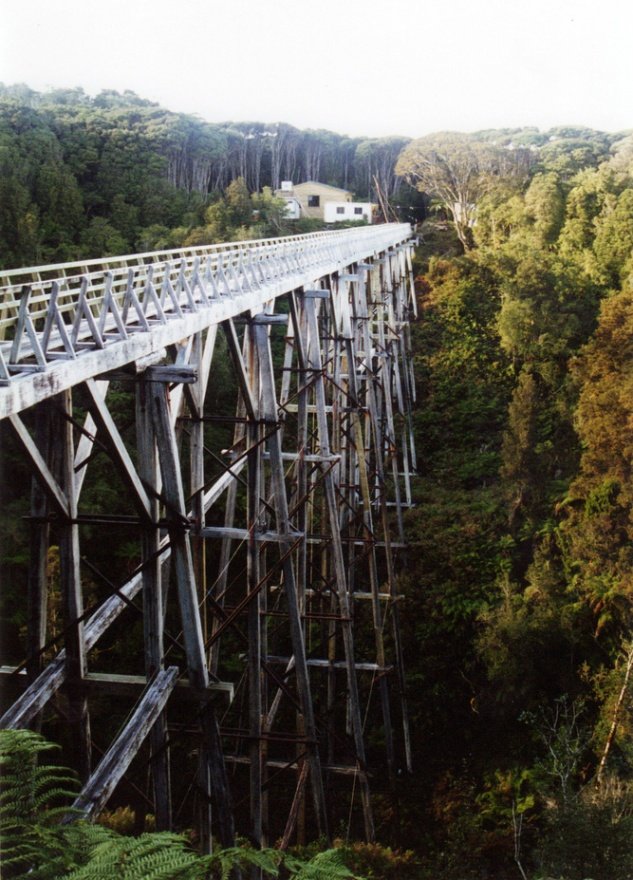
Percy Burn Viaduct (1925)
Last stand for native logging
Until the large-scale planting of exotics began, native timber was cut down ruthlessly and without much thought for the future. The large Marlborough Timber Company was doing precisely that 100 years ago. It had been exporting vast quantities of timber from Queen Charlotte Sound, but the directors knew that soon they would have to look for new forests. Large stands of native bush were becoming scarce, but Māori owners were happy to sell cutting rights at Mussel Beach at the western side of Te Waewae Bay, Southland. It was practically inaccessible by land but since director Daniel Reese also ran ships, the company started building a wharf and rubble breakwater here in 1916-17. Soon there was an entire community down at Port Craig, as they renamed Mussel Beach to commemorate two Craigs who died setting up the project. After many delays the mill opened on 22 September 1921.
No one could accuse the company of not aiming high. Impressed by North American technology and methods, it imported a Lidgerwood Overhead Logging Plant, a huge 80-tonne steam skidder to haul logs along an overhead cableway. At ground level nearly 25 km of tramways snaked through the bush to feed logs into the mill, New Zealand’s largest and most modern. To cross the rivers – or ‘burns’ as they are called in this part of the country – the company built four viaducts, all, ironically, from Australian hardwood. These were Sand Hill (now Peter Burn), 59 m long and 17 m high; Percy Burn, 125 m and 36 m; Edwin Burn, 50 m and 22 m; and Francis Burn, 52 m and 14 m. To top this all off, in 1928 the company erected a huge gantry at the end of the wharf to load ships moored in the bay by an aerial loading system.
But Port Craig had over-invested. The mill had cost more than expected and further investment just made things worse. The native bush was too sparse and patchy to allow the Lidgerwood to work efficiently; soon it was abandoned with boiler trouble. Company debt rose with each tree that fell. The directors put in more money, but competition from West Coast timber (now reaching southern cities via the new Ōtira rail tunnel) and falling prices brought it to its knees in October 1928, when the steamer Oreti brought out 140 refugees (another 60 walked out).
The mill opened briefly in 1930 but closed within months, this time for good. Salvors removed some machinery, but left most to decay, where it remains, along with the school (now a tramping hut) and the viaducts, which were re-decked as footbridges. More recently the Port Craig Viaducts Charitable Trust restored them and they are now flagships of the Hump Ridge tourist trail. In May 2013 the Percy Burn Viaduct was closed to the public on safety grounds. It is now fenced off, but visitors can still see it from a bypass built by the Department of Conservation.
Hi! I am a robot. I just upvoted you! I found similar content that readers might be interested in:
https://nzhistory.govt.nz/media/photo/percy-burn-viaduct
Downvoting a post can decrease pending rewards and make it less visible. Common reasons:
Submit
Congratulations! This post has been upvoted from the communal account, @minnowsupport, by steemfollow from the Minnow Support Project. It's a witness project run by aggroed, ausbitbank, teamsteem, theprophet0, someguy123, neoxian, followbtcnews, and netuoso. The goal is to help Steemit grow by supporting Minnows. Please find us at the Peace, Abundance, and Liberty Network (PALnet) Discord Channel. It's a completely public and open space to all members of the Steemit community who voluntarily choose to be there.
If you would like to delegate to the Minnow Support Project you can do so by clicking on the following links: 50SP, 100SP, 250SP, 500SP, 1000SP, 5000SP.
Be sure to leave at least 50SP undelegated on your account.
Downvoting a post can decrease pending rewards and make it less visible. Common reasons:
Submit